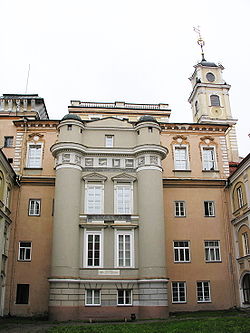Vilnius University Astronomical Observatory

The building of old Astronomical Observatory (south extension by Marcin Knackfuss)
|
|
| Organization | Vilnius University |
|---|---|
| Observatory code | 70 (before 1939), 570 (after 1939) |
| Location | Vilnius, Lithuania |
| Coordinates | 54°40′59.2″N 25°17′11.4″E / 54.683111°N 25.286500°ECoordinates: 54°40′59.2″N 25°17′11.4″E / 54.683111°N 25.286500°E |
| Altitude | 101 metres (331 ft) |
| Established | 1753 |
| Website | www |
|
[]
|
|
Vilnius University Astronomical Observatory is an astronomical observatory of Vilnius University. It was founded on 1753 by initiative of Thomas Zebrowski. The observatory is the fourth oldest observatory in the Europe. While the observatory is no longer able to make astronomical observations due to light pollution in Vilnius (observations are carried out at Molėtai Astronomical Observatory), it continues scientific research.
The construction was funded by Elżbieta Ogińska-Puzynina. First telescope (13.5 cm reflector) was donated by Michał Kazimierz "Rybeńko" Radziwiłł, Supreme Commander of the army of the Grand Duchy of Lithuania. Second, 10 cm reflector, was donated by bishop of Vilnius Józef Stanisław Sapieha.
The golden age of Astronomical Observatory has begun when Marcin Odlanicki Poczobutt was director of the Observatory (1764–1807). He was very skillful observer and left a lot of observational data. Later these observations were used by Jérôme Lalande in his calculations of Mercury orbit. Poczobutt also decided to build an extension of the observatory to the south. It was designed and built by the famous architect Marcin Knackfuss in 1782–88.
Later the observatory was headed by Jan Sniadecki (1807–1825) and Piotr Slawinski (1825–1843). They observed planets, their satellites, asteroids and comets, eclipses of the Sun and Moon. In 1861, G. Sabler, the director of the observatory, proposed to acquire for that purpose new instruments, among which there were a solar photoheliograph, a photometer and a spectroscope. Spectroscopic observations of the Sun and photometric observations of stars were initiated.
...
Wikipedia

